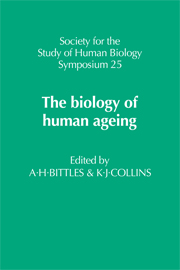Book contents
- Frontmatter
- Contents
- Preface
- Ageing as a consequence of natural selection
- Genetic information in ageing cells
- Insects as models for testing theories of ageing
- Human cell culture systems in the study of ageing
- Estimation of biological maturity in the older child
- Biological age assessment in adulthood
- Skeletal age and palaeodemography
- Cell death and the loss of structural units of organs
- The prospects for mortality decline and consequent changes in age structure of the population
- Where do old people come from? An evaluation of American population projections
- Age structure of Soviet population in the Caucasus: facts and myths
- The health of an ageing population
- Can we tell our age from our biochemistry?
- Dietary manipulation of ageing: an animal model
- Customary physical activity in the elderly
- Effects of ageing on human homeostasis
- Index
Effects of ageing on human homeostasis
Published online by Cambridge University Press: 06 August 2010
- Frontmatter
- Contents
- Preface
- Ageing as a consequence of natural selection
- Genetic information in ageing cells
- Insects as models for testing theories of ageing
- Human cell culture systems in the study of ageing
- Estimation of biological maturity in the older child
- Biological age assessment in adulthood
- Skeletal age and palaeodemography
- Cell death and the loss of structural units of organs
- The prospects for mortality decline and consequent changes in age structure of the population
- Where do old people come from? An evaluation of American population projections
- Age structure of Soviet population in the Caucasus: facts and myths
- The health of an ageing population
- Can we tell our age from our biochemistry?
- Dietary manipulation of ageing: an animal model
- Customary physical activity in the elderly
- Effects of ageing on human homeostasis
- Index
Summary
INTRODUCTION
From the evidence of a few longitudinal and many cross-sectional studies, human ageing can be characterised by a general decline in functional competence of the whole organism and a reduced capacity to respond as efficiently as younger individuals to internal and external stresses. This has become embodied in homeostatic theories of ageing, seen as a destabilisation of the internal environment of the organism and a limitation of the ability to bring about adaptive reactions. Because of their widespread influence on many integrated homeostatic mechanisms, the neural and endocrine centres of control in the hypothalamus are sometimes identified as possible centres of influence in the ageing process. Thus, theories attributing a key role to loss of sensitivity of hypothalamic neurones to neural or endocrine feedback signals have been proposed (Dilman, 1971; Dilman et al, 1979). Finch (1975, 1978, 1980) sees the loss of catecholamines in the hypothalamus and other parts of the brain as an important expression of the ageing process.
These theories seek to explain declining control of homeostasis in terms of metabolic and organisational deficiencies in hypothalamic nerve cells or their receptors. Though a number of observations testify to significant changes in centres of neural control which may be of value as biological markers of ageing (Reff & Schneider, 1982) it is probable that the decline in functional organisation of hypothalamic neurones controlling homeostasis is but an integral part of the overall ageing process, for structural and functional age changes can also be demonstrated in peripheral afferent and effector components of most physiological systems during ageing.
- Type
- Chapter
- Information
- The Biology of Human Ageing , pp. 261 - 275Publisher: Cambridge University PressPrint publication year: 1986
- 2
- Cited by

